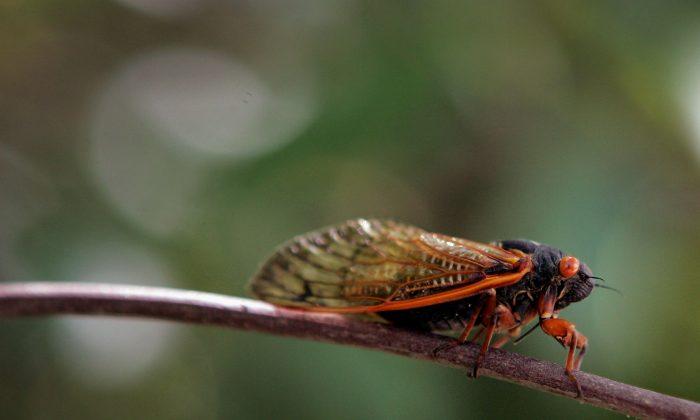As the weather gets warmer, and the dog days draw nearer, the whole of nature seems to awaken.
This means cicadas, hundreds of millions of them, will soon descend onto American counties.
Every year, these ancient insects emerge from the soil in eye-wateringly large numbers to molt their adolescent skins and emerge winged.
Here are some interesting facts about periodical cicadas.

1. Seven Species
Although there are upwards of 3,000 species of the insect, periodical cicadas are perhaps the best known in the Western hemisphere. Under the Magicicada genus, periodical cicadas are the longest living subtype of the cicada family, living 13 or 17 years, depending on the species.
There are only seven species of periodical cicadas—three that follow 17-year cycles and four that emerge every 13 years. Each of these seven species have unique songs.
Spring 2016’s invasion—identified as Brood V—will feature all three of the the 17-year species: Magicicada cassinii, Magicicada septendecim, and Magicicada septendecula.
2. Life Cycle
Female cicadas lay up to 600 fertilized eggs. They deposit unhatched young in batches of 20 in V-shaped grooves the mother carves out of tree bark.
After 6 to 10 weeks the newborn cicada nymphs hatch and drop to the ground. The nymphs burrow underground—within 2 feet of the ground’s surface—and spend the next 13 to 17 years of their life feeding off the xylem they sap from plant roots.

During their subterranean life, periodical cicadas undergo five instar stages, or molting stages.
When ready, periodical cicada nymphs emerge from the ground, climb up trees and plants until they reach an appropriate height. Nymphs will undergo a final molt, emerging in their adult form as a snowy white color.
Within a few hours, the exoskeleton of the now sexually mature cicadas will darken and the insects will be ready to mate. Cicadas live in this form for roughly 2 weeks—they mate, the females lay eggs, and then they die.

3. Temperature Activated
Two weeks prior to their grand entrance, cicada nymphs dig tunnels in the soil surrounding the trees that had been nurturing them with sap for the past 13 to 17 years.
Imagine if both male and female cicadas produced the cicadas tell-tale song!
Persons in cicada-dense areas—which in 2016 happen to be southeastern Pennsylvania, the western tip of of Maryland, the majority of West Virginia, a sliver of Virginia, the eastern portion of Ohio, and Suffolk County in Long Island, New York—wouldn’t be able to sleep!

5. Snap of the Wings
While many may not consider the males’ choir very beautiful—or pleasant—female cicadas adore it and in response they click their wings. You can imitate the females’ call by snapping your fingers.
In fact, as Sir David Attenborough demonstrates in the video below, male cicadas will even follow your snapping fingers, believing them to be coming from an attractive female.
If you use power tools, mow your lawn, or wield any other “vibrating machinery” during their invasion, you may find soon yourself covered in cicadas.
Cicada Mania—a website dedicated to cicadas—recommends only using this equipment at dawn or dusk, when the creatures are less active.





Friends Read Free